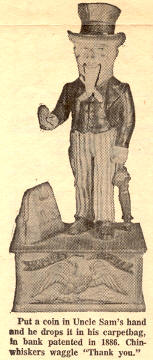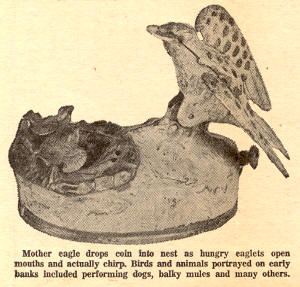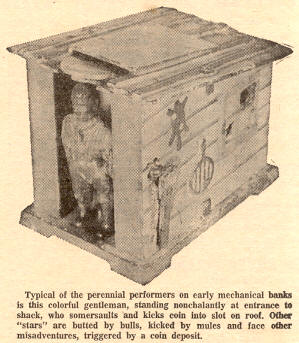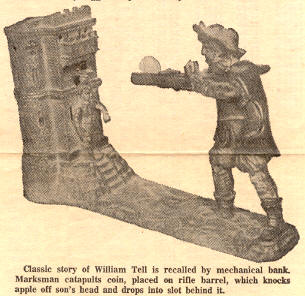|
COIN WORLD, December 21, 1966
Spotlight Moves Back
Through Time, Revealing
19th Century Joy Makers
Early Mechanical Banks
Rate As Educational Toys
By Jay Guren

A quick glance through any toy catalog makes Christmas, 1966
seem like our merriest mechanized one yet. When we see the
animation "canned" electric power puts into every kind
of toy, from robots to racers, to baby dolls, we can't help but
ponder over the dull, "dead" toys of Yesteryear.
This of course, is only until we strike
upon that one great area of juvenile joy in the past, the
mechanical bank. It becomes pure numismatic whimsey, to roll
back the clock a few decades, and look in on a typical Christmas
eve.
The year is 1877; the day, December 24.
A mantle of snow covers the ground, and an occasional sleigh
glides over it, silently, except for the silvery twinkle of the
horses' bells. Evening has come soon, and it appears as if more
snow will fall by Christmas day.
One sleigh glides to a halt beside a
merchant's house. The blankets in which the rider is wrapped
also conceal gifts for the children. Among them is one the
merchant has silently chuckled over most of the way home. Like
dads since Santa Claus was first conceived, he has already tried
out this gift.
The merchant has long since convinced
himself that this is an educational toy, one which will teach
his seven - year - old the importance of thrift. A cast iron
soldier stands with rifle in hand taking aim and ready to
project the coin which has been placed on the rifle barrel into
a slot on a tree trunk

The doting father also
has thoughtfully provided some ammunition: Ten gleaming, new Indian Head
cents. Their eventual fate is difficult to determine; we can be certain
however, that they will not be in Uncirculated condition, if ever
retrieved for a collection. The bank, on the other hand, will amuse this
seven-year - old, the brothers and sisters who follow him, and still
another generation or two of children, before passing through the hands
of an auctioneer to a collector.
And the collector, on Christmas, 1966, will
lure a grandchild of his own from the slick, battery - operated toys
under the Christmas tree, to the old, coin-operated marksman!

The development of the mechanical bank in the later portion of the 19th
century represented the peak of a trend which began in 1793, the same
year the first U.S. coins were struck by the Philadelphia Mint. These
banks, because of their basic purpose, have enjoyed a tenuous
relationship to numismatics right through to the present day, when they
are assiduously collected as many coin series.
Indeed, the ranks of mechanical bank collectors
include such dedicated numismatists as Larry Freeman and Coin World's
associate editor, James G. Johnson. The former was co-author with John
D. Meyer of the volume, "Old Penny Banks," published in 1960
by Century House, Watkins Glen, N. Y.
The virtues propounded by Benjamin Franklin
regarding thrift no doubt had their effect on the early generations of
the Republic, and made popular the first clay or pottery banks, as well
as glass and tin banks. The pottery and glass banks not designed with
much consideration for the collecting interests of posterity; once
filled with coins, they had to be shattered, if the accumulated savings
were to be enjoyed. The period of hard times associated with the Jackson
administration no doubt took many treasured specimens of these early
banks out of circulation.
Tin banks, soldered together and painted in
bright colors, were generally replaced by cast iron after 1860. These
first cast iron banks were "still," depicting houses, historic
landmarks, animals and birds. A decade later, the "action"
banks came on the scene.

Mechanical banks "sugar-coated" the concept of thrift, while
at the same time providing some form of entertainment. Various
mechanisms, patented generally by Yankee inventors, caused a little girl
to skip rope; a bear to open his mouth and swallow the coin, or a bird
to deposit the coin in the chimney of a church building.
These feats were mild, of course, compared to
that of the "Paddy and His Pig" bank. Here the coin is placed
on the pig's nose, which Paddy holds between his legs. When a lever is
pressed, the pig kicks the coin into Paddy's mouth, and Paddy rolls his
eyes.
Loose and lanky performers were the subjects of
many mechanical banks. An old-time showman stands in the doorway of the
"Cabin Bank" in the Johnson collection. He turns a somersault,
and kicks the coin through a slot in the roof, when the handle on the
brush which hangs on the side of the cabin is moved.
Equally popular were performing dogs and
monkeys, balky mules, frogs and elephants.
The mechanical banks were regarded as quite
"special" gifts at Christmas, and sold at retail, at from $1
to $5. These represented fairly substantial prices to pay for a toy in
the 19th century. However, they apparently proved worth their price, and
many have remained operational for over nine decades.
Although the concept of thrift has been
replaced by the friendly loan company, and the spring-and-lever and
other mechanisms by the dry cell battery, the "penny banks" of
yesteryear still have great special appeal -- for youngsters and
oldsters alike. Ask anyone who has ever placed a coin in one.
|




